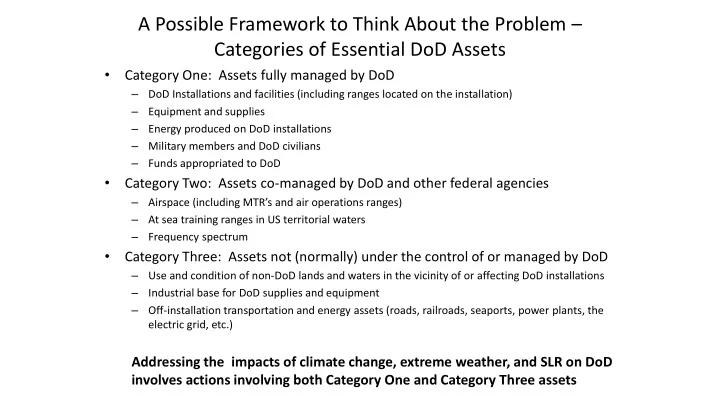

A Possible Framework to Think About the Problem – Categories of Essential DoD Assets • Category One: Assets fully managed by DoD – DoD Installations and facilities (including ranges located on the installation) – Equipment and supplies – Energy produced on DoD installations – Military members and DoD civilians – Funds appropriated to DoD • Category Two: Assets co-managed by DoD and other federal agencies – Airspace (including MTR’s and air operations ranges) – At sea training ranges in US territorial waters – Frequency spectrum • Category Three: Assets not (normally) under the control of or managed by DoD – Use and condition of non-DoD lands and waters in the vicinity of or affecting DoD installations – Industrial base for DoD supplies and equipment – Off-installation transportation and energy assets (roads, railroads, seaports, power plants, the electric grid, etc.) Addressing the impacts of climate change, extreme weather, and SLR on DoD involves actions involving both Category One and Category Three assets
Existing DoD Authorities • Asset categories one and two – Extensive in both law and regulation, exercised through extensive and detailed internal DoD procedures linked tightly to requirements and budgets/funding • Asset category three – Fairly broad in the context of holding discussions and providing DoD input to external meetings and processes – but with some constraints – Broad (but infrequently used) authority to address issues related to the DoD industrial base • Defense Production Act (50 USC App. 2061 et seq.) – Several limited authorities to provide grants to external entities • OEA JLUS planning grants (10 USC 2391) • Impact aid to local schools (20 USC 7703) • Defense Access Roads program (23 USC 210) – Several tailored authorities to form funded public-private partnerships • The “REPI” program to address encroachment from incompatible development and/or loss of habitat for species of DoD concern (10 USC 2684a) • Management of off-post habitat under certain conditions (16 USC 670c-1)
Does DoD Have Enough Authority to Assure Resilience? • In a word, no . • In the case of using existing “Category One” authorities, DoD needs to fully integrate assessments of risks to resilience and required responses (both inside and outside the “fence line”) to the Unified Facilities Criteria (UFC) and Installation Master Planning (IMP) processes in order to link required responses to the DoD requirements and budgeting processes • In the case of “Category Three” assets, additional authorities are needed to allow formation of true (and funded) public-private partnerships between DoD and local/regional/state authorities and others to address climate risks to DoD • Possible options (there are others): – Create a “REPI - like” authority specifically focused on collaborative resiliency measures outside the “fence line” – Amend the Defense Access road authority to include measures to enhance the resiliency of local road nets critical to DoD – Amend the Defense Production Act (up for reauthorization in 2019) to include relevant authorities to ensure the resilience of key external DoD assets (transportation, energy, etc.) – Amend the FEMA pre-disaster mitigation grant program to give priority to DoD communities (section 203 of the Stafford Act, 42 USC 5133)
Extracts from section 336 of the House version of the FY 2018 NDAA • REPORT REQUIRED. — Not later than one year after the date of the enactment of this Act, the Secretary of Defense shall submit to the Committees on Armed Services of the Senate and the House of Representatives a report on vulnerabilities to military installations and combatant commander requirements resulting from climate change over the next 20 years. • ELEMENTS. — The report on vulnerabilities to military installations shall include the following: • A list of the ten most vulnerable military installations within each service based on the effects of rising sea tides, increased flooding, drought, desertification, wildfires, thawing permafrost, and any other categories the Secretary determines necessary. • An overview of mitigations that may be necessary to ensure the continued operational viability and to increase the resiliency of the identified vulnerable military installations and the cost of such mitigations. • An overview of mitigations that may be necessary to ensure mission resiliency and the cost of such mitigations. • The report shall be submitted in unclassified form, but may contain a classified annex.
Extracts from the SASC report on their mark of the FY 2018 NDAA: • The Secretary of Defense shall submit to the congressional defense committees a comprehensive threat assessment and implementation master plan no later than March 1, 2018 on the risks and vulnerabilities to DOD missions and infrastructure associated with climate-related events. The assessment and master adaptation plan shall include: • Effects and mission impacts of a changing climate, if any, on DOD operations, testing and training ranges, readiness, basing, acquisition, contingency basing, command and control, supply chain, logistics, stockpiles, and the associated costs • Plans and procedures to continue missions in the event of loss or damage to critical energy and water infrastructure • Adaptation plans and procedures to ensure military investments with taxpayer dollars are constructed to better withstand flooding and extreme weather events • Updates to built and natural infrastructure design, changes to military construction standards, Unified Facilities Criteria, and encroachment procedures • Improved modeling techniques and data sources to better predict future erosion, flooding, and other extreme weather events • Opportunities to pursue public-private partnerships under existing authorities with any non-DOD entity in order to mitigate climate related impacts • Adaptation progress metrics and recommendations for further research and development • Strategies and recommendations to alleviate climate vulnerabilities, including timelines and resource requirements • Any other aspects deemed appropriate
Recommend
More recommend